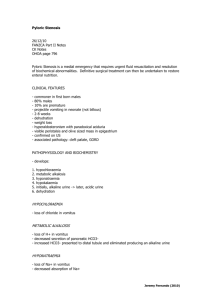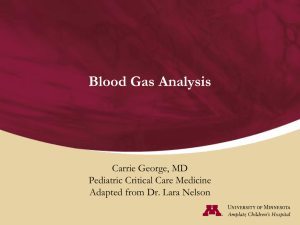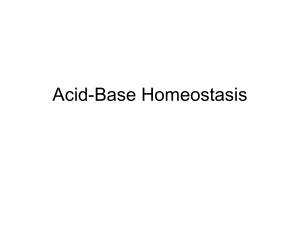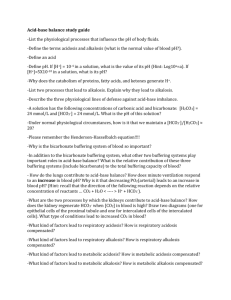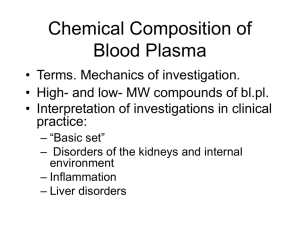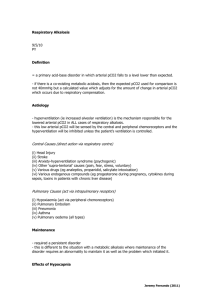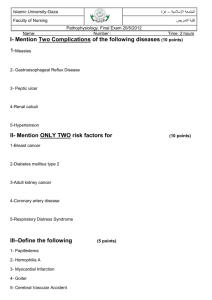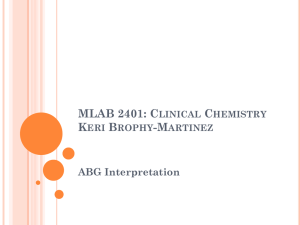Sputum Examination
advertisement
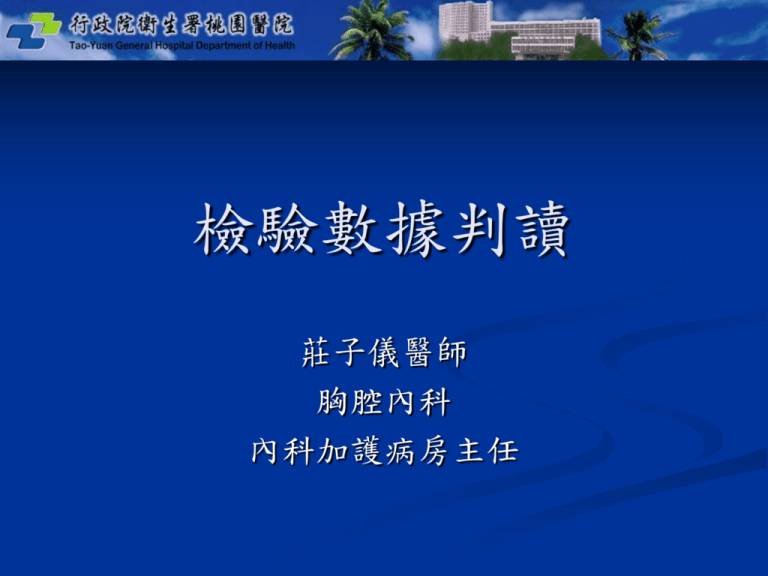
檢驗數據判讀 莊子儀醫師 胸腔內科 內科加護病房主任 Why do you need to check lab? How do you evaluate a patient? Interrogation Physical examination Blood examination Image examination Special examination Classification of lab work Hematology test Blood biochemistry Serology Body fluid Urine and stool Bacteriology and virology Histopathology Hematology test What kind of patient do you need to check hematology test? Symptoms and signs of blood loss, inadequate blood production Symptoms and signs of infection, inflammation and malignancy Symptoms and signs of coagulopathy Routine Complete Blood Count (CBC) Hemoglobin (Hb) Hematocrit (Hct) Red blood cells (RBCs) Hct 1000 MCV Mean cell volume (MCV) RBC ( in millions / uL ) Mean cell hemoglobin conc. (MCHC) g / dL ) White blood cells (WBCs) MCHC Hb ( inHct Differential count Platelet count CBC What do you expect if patient has blood loss? Macrocytic, normocytic or microcytic anemia? MCV, RBC increase or decrease Normochromic, or hypochromic anemia? Hb, Ht decrease MCH, MCHC normal or decrease Acute or chronic? Reticulocyte count WBC What do you expect if patient has infection, inflammation or malignancy? WBC increase or decrease Leukocytes shift to left Monocytes increase Abnormal or immature WBC Thrombocytopenia PLT What do you expect if patient has coagulopathy? Thrombocytopenia PT, aPTT increase Pancytopenia CBC, WBC, PLT decrease Severe infection Malignancy Drug effect Liver cirrhosis, uremia etc. Blood biochemistry Liver function Renal function Cardiac enzymes Diabetic test Liver function Albumin, bilirubin, PT AST, ALT, ALP, rGT Albumin Produced by the liver and contributes approximately 80% of serum colloid osmotic pressure T1/2 of albumin is about 20 days Lost directly from the blood because of hemorrhage, burn, or exudates, or it may be lost into the urine or stool because of nephrotic syndrome and chronic diarrhea Bilirubin Breakdown product of Hb Exceeds 0.2-0.4 mg/dL, bilirubin will begin to appear in the urine Conjugated bilirubin: water soluble, measured as D-bil Unconjugated bilirubin: water insoluble, bound to serum albumin, measured as T-bil – D-bil Bilirubin Increased direct (conjugated): hepatocelluar injury, biliary obstruction/cholestasis (gallstone, tumor, stricture, drug-induced) Increased indirect (unconjugated): so-called “hemolytic jaundice” caused by any type of the hemolytic anemia, newborn jaundice Prothrombin time Direct measurement of activity of clotting factors VII, X, prothrombin (factor II), and fibrinogen The INR is the PT ratio that would result if WHO’s international reference thromboplastin were used to test the pt’s blood sample Aspartate Aminotransferase Abundant in heart and liver tissue and moderately present in skeletal muscle, the kidney, and the pancreas Evaluate myocardial injury and to diagnose and assess the prognosis of liver disease resulting from hepatocellular injury Higher than that of ALT in cirrhosis Alanine Aminotransferase Relatively more abundant in hepatic tissue, more liver-specific enzyme ALT>AST in viral hepatitis, AST >ALT in alcohol hepatitis Alkaline Phosphatase Different physiochemical properties and originate from different tissues: liver, bone, placenta, intestine The presence of early bile duct abnormalities can result in ALP before bilirubin are observed. Alkaline Phosphatase Drug induced cholestatic jaundice (eg., chlorpromazine or sulfonamides) can ALP. ALP is an excellent indicator of spaceoccupying lesions in liver because of disruption of biliary canaliculi within liver. -Glutamyl Transferase Major clinical value for hepatobiliary disease. GT is a sensitive indicator of recent alcohol exposure (GT/ALP>1.4). More responsive to biliary obstruction (5-50 times of upper limit of normal) Useful in the diagnosis of obstructive jaundice, intrahepatic cholestasis Case discussion 24歲男性病人,主訴疲倦,深棕色尿,身體 檢查呈現黃疸,lab data如下: AST (IU/L): 1543 (5-40) ALT (IU/L): 2230 (15-40) T-Bilirubin (mg/dl): 16 (0.2-1.3) D-Bil. (mg/dl): 11.1 (0.1-0.4) Renal function BUN, creatinine, electrolytes Blood gas, lactic acid Urine analysis Blood Urea Nitrogen End-product of protein metabolism Azotemia (elevation of BUN) Dehydration Blood loss Steroid Renal failure Heart failure Creatinine Derived from creatine and phosphocreatine, major constituent of muscle Ccr reflects the glomerular filtration rate (GFR) (140 age) (body wt in kg) for males ( SrCr )( 72) If for females 0.85 Clcr ( ml / min) Creatinine BUN:Cr ratio BUN/Cr >20 in prerenal and postrenal azotemia BUN/Cr <12 in acute tubular acidosis BUN/Cr between 12 and 20 in intrinsic renal disease Urine Normal are not present (eg., glucose, blood, ketone, and bile pigments) Appearance: slightly yellow, clear pH: 5.0~8.0 Specific gravity : 1.005~1.030 Occult blood (O.B): not present Sugar : not present Protein : not present Bilirubin/urobilinogen Nitrite/leukocyte esterase Microscopic examination: RBC(0-2)HPF, WBC(0-6), cast(0-2), yeast, crystals(0-3), and epithelial cells(0-5) Blood gas Step 1 Step 2 pH = ? Acidosis / Alkalosis HCO3- or PCO2 ? Metabolic or Respiratory Step 3 Well compensation ? Mix ? Blood gas PH HCO3 Metabolic acidosis Respiratory acidosis Metabolic alkalosis Respiratory alkalosis PCO2 Blood gas Metabolic acidosis: PCO2= 1.5x HCO3- +(8 ± 2) Metabolic alkalosis: HCO3- 1 nmol/L PCO2 0.6~0.7 mmHg Respiratory acidosis Acute : PCO2 10 mmHg HCO3- 1 nmol/L Chronic : PCO2 10 mmHg HCO3- 4 nmol/L Respiratory alkalosis Acute : PCO2 10 mmHg HCO3- 2 nmol/L Chronic : PCO2 10 mmHg HCO3- 5 nmol/L Blood gas PH HCO3 PCO2 Metabolic acidosis Respiratory acidosis Metabolic alkalosis Respiratory alkalosis Case discussion 22歲男性病人主訴有下肢水腫,五年前有急 性腎絲球腎炎病史及輕微的蛋白尿。血壓 130/84mmHg,實驗室檢查結果如下: RBC in urine (0~1) :8~10/HPF Albumin in urine (neg) : 4+ 24-hrs urine protein(0~150) : 829 mg/24hr Serum total protein (6~8) : 7.6 gm/dL Serum albumin (3.5~5.0) : 2.0 gm/dL Serum total cholesterol (125~200) :483 mg/dL Cardiac enzymes CKtotal CK-MB SGOT LDH total LDH-1 Creatine Kinase Suspected MI or muscle disease, heart, skeletal muscle, and brain with high levels. Total CK can be increase by strenuous exercise, IM injections of drugs that are irritating to tissue (eg., diazepam, phenytoin), acute psychotic episodes or myocardial injury. Creatine Kinase CK-MB: myocardium,(3-10 U/L) increased in acute MI (begin in 2-12hrs, peak at 12-40 hrs, returns to normal in 24-72 hrs), pericarditis with myocarditis, rhabdomyolysis, crush injury, Duchenne’s muscular dystrophy, polymyositis, malignant hyperthermia, and cardiac surgery. CK-MB level >25 U/L usually are associated with a MI, the absolute amount may vary depending on the assay technique used. Troponin-I The detection of the presence of troponin T and I is more specific and sensitive indicator of myocardial damage. Troponin within 4hrs of AMI, enabling clinicians to initiate appropriate therapy very quickly following presentation to the ED. Diabetic test Glucose AC/PC HbA1c Glucose AC/PC The fasting plasma glucose and 2hrs postprandial glucose tests commonly are used for evaluating glucose homeostasis. Diagnosis of DM: Fasting blood glucose>126 mg/dL Symptoms of diabetes plus a random plasma glucose 200 mg/dL Plasma glucose 200 mg/dL at 2hrs following a 75g glucose load HbA1c Measurement of HbA1C (normal range 4.66.5% ) indicative of glucose control during the preceding 2-3 months. Normal Values Abnormal laboratory values are not always of diagnostic significance and normal values sometimes can be interpreted as being abnormal in some disease. Various factors (eg., age, gender, weight, height, time since last meal, drugs) can affect the range of normal values for a given test. Each laboratory has its own set of normal value. Laboratory Error Spoiled specimen Specimen taken at wrong time Incomplete specimen Faulty reagents Technical errors Diagnostic and therapeutic procedures Diet Medication Thank You for Your Attention
